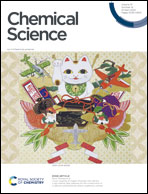Monitoring water harvesting in metal–organic frameworks, one water molecule at a time†
Abstract
Metal–organic frameworks (MOFs) have gained prominence as potential materials for atmospheric water harvesting, a vital solution for arid regions and areas experiencing severe water shortages. However, the molecular factors influencing the performance of MOFs in capturing water from the air remain elusive. Among all MOFs, Ni2X2BTDD (X = F, Cl, Br) stands out as a promising water harvester due to its ability to adsorb substantial amounts of water at low relative humidity (RH). Here, we use advanced molecular dynamics simulations carried out with the state-of-the-art MB-pol data-driven many-body potential to monitor water adsorption in the three Ni2X2BTDD variants as a function of RH. Our simulations reveal that the type of halide atom in the three Ni2X2BTDD frameworks significantly influences the corresponding molecular mechanisms of water adsorption: while water molecules form strong hydrogen bonds with the fluoride atoms in Ni2F2BTDD, they tend to form hydrogen bonds with the nitrogen atoms of the triazolate linkers in Ni2Cl2BTDD and Ni2Br2BTDD. Importantly, the large size of the bromide atoms reduces the void volume in the Ni2Br2BTDD pores, which enable water molecules to initiate an extended hydrogen-bond network at lower RH. These findings not only underscore the prospect for precisely tuning structural and chemical modifications of the frameworks to optimize their interaction with water, but also highlight the predictive power of simulations with the MB-pol data-driven many-body potential. By providing a realistic description of water under different thermodynamic conditions and environments, these simulations yield unique, molecular-level insights that can guide the design and optimization of energy-efficient water harvesting materials.



 Please wait while we load your content...
Please wait while we load your content...